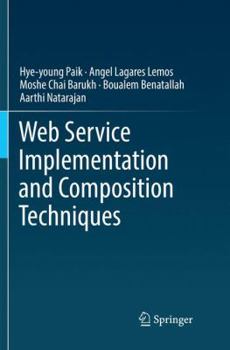Web Service Implementation and Composition Techniques
Select Format
Select Condition 
Book Overview
1 Introduction to Service Oriented Architecture.- 1.1 The Service Oriented Architecture Paradigm.- 1.1.1 Goals of Service Orientation.- 1.1.2 What is a Service?.- 1.1.3 The SOA Architectural Stack.- 1.2 Service Composition and Data-Flow.- 1.2.1 Data-Flow Paradigms.- 1.2.2 Composition Techniques.- 1.2.3 End-user Mashups.- 1.3 Goals, Structure and Organization.- 1.4 Lab Exercise 00 - Practical Exercise Environment Setup.- 1.4.1 SOA-Book Github Site.- 1.4.2 Preliminaries.- 1.4.3 Installing Apache Maven and Eclipse Maven Plug-in.- 2 Web Services - SOAP and WSDL.- 2.1 Simple Object Access Protocol (SOAP).- 2.1.1 Binding SOAP Messages to a Transportation Protocol.- 2.1.2 SOAP Extension using SOAP Headers.- 2.2 Web Services Description Language (WSDL).- 2.3 WSDL Main Elements.- 2.4 Message Communication Model in SOAP/WSDL.- 2.4.1 RPC-style.- 2.4.2 Document-style.- 2.5 Lab Exercise 01 - Developing simple Web services with Apache CXF and Maven.- 2.5.1 Activity 1: Hello World with Apache CXF.- 2.5.2 Activity 2: Building Simple Services.- 2.6 Lab Exercise 02: Fault handling in Apache CXF and Web service client development.- 2.6.1 Activity 1: Adding SOAP Faults to Top Down Simple Service.- 2.6.2 Activity 2: Developing a Web Service Client Application.- 3 Web Services - REST or Restful Services.- 3.1 REST Design Principles.- 3.2 Resources.- 3.3 Resource Identification.- 3.4 Addressability.- 3.5 Statelessness.- 3.6 Resource Representations.- 3.7 Uniform Interfaces in REST.- 3.8 Web API Design for RESTful services.- 3.8.1 Designing URIs.- 3.8.2 Design of the Responses.- 3.8.3 HATEOAS - Taking your API to the Next Level.- 3.9 REST-based Service Implementation.- 3.9.1 Building REST Web services.- 3.10 Lab Exercise 03: A Simple REST Service with Apache CXF (JAX-RS).- 3.10.1 Activity 1: Start with Hello World.- 3.10.2 Activity 2: Testing the HelloWorld service.- 3.10.3 Activity 3: CRUD Operations on Resources.- 3.10.4 Activity 4: Developing a Client for RESTful Services.- 4 Web Services - Data Services.- 4.1 Data Services.- 4.1.1 WS-* and RESTful services.- 4.1.2 Data Access as a Service.- 4.2 Implementing Data Services.- 4.3 XML Transformation and Query Techniques.- 4.3.1 XPath.- 4.3.2 XSLT.- 4.3.3 XQuery.- 4.4 Exposing Data as Services.- 4.5 Lab04: Data Service Enablers - XSLT and XQuery.- 4.5.1 Working through XSLT examples.- 4.5.2 Working through XQuery examples.- 5 Web Service Composition: Overview.- 5.1 From Atomic to Composite Services.- 5.2 Service Orchestration vs. Service Choreography.- 5.3 Service Composition View from Orchestration and Choreography.- 5.4 Benefits of Web service composition.- 5.5 Web Service Composition Environment.- 6 Web Service Composition: Control Flows.- 6.1 BPEL (Business Process Execution Language).- 6.1.1 BPEL Model.- 6.1.2 BPEL Example.- 6.2 BPMN (Business Process Model and Notation).- 6.2.1 BPMN Model.- 6.2.2 BPMN Example.- 6.3 Lab Exercise 05: Web service composition with BPEL and Apache ODE.- 6.3.1 Software Setup.- 6.3.2 Activity 1: Hello World in BPEL.- 6.3.3 Activity 2: Simple Home Loan Process Service.- 7 Web Service Composition: Data Flows.- 7.1 Data-Flow Paradigms.- 7.1.1 Blackboard.- 7.1.2 Explicit Data Flow.- 8 Service Component Architecture (SCA).- 8.1 Introduction to SCA.- 8.1.1 The SOA Integration Problem.- 8.1.2 Overview of SCA.- 8.1.3 Application of SCA to Use-Case.- 8.1.4 SCA Runtime.- 8.1.5 Benefits of SCA.- 8.2 The Stock Application.- 8.3 The SCA Assembly Model.- 8.3.1 SCA composite.- 8.3.2 SCA Component.- 8.4 Lab Exercise 06: SCA.- 8.4.1 Activity 1: Building the first SCA composite - Hello World Service.- 8.4.2 Activity 2: Building the Stock Application.- 9 Conclusion.- References.- Index.
Format:Paperback
Language:English
ISBN:3319856898
ISBN13:9783319856896
Release Date:August 2018
Publisher:Springer
Length:256 Pages
Weight:0.85 lbs.
Dimensions:0.6" x 6.1" x 9.2"
Customer Reviews
0 rating





